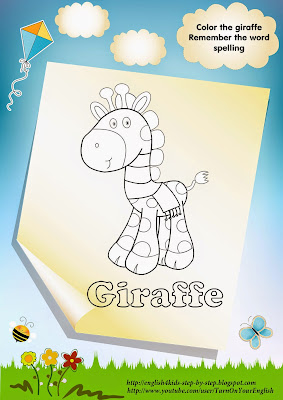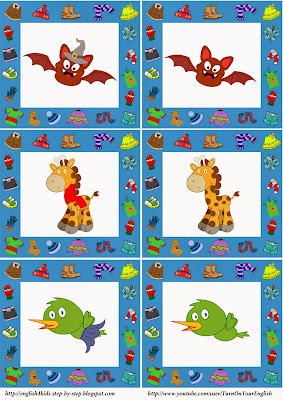I've decided to cooperate with another ESL teacher living in my city to expend the creative mind involved in my teaching activities and share new ideas with the English teachers' community. Her name is Julia Hetman and this post introduces her first contribution to my blog and YouTube channel. She has written lyrics for my new children's song. This song is about clothing and can be used for corresponding English lessons covering the clothes vocabulary. The lyrics are also good to teach the Present Continuous (Progressive) tense to as little kids as preschoolers if not toddlers. I asked Julia to write an article giving ESL teachers an idea on how the song can be used. So here is her article.
This information is meant for educators and parents who are constantly seeking new ways to make English classes more exciting and productive for children.
This article has to do with the Present Continuous tense, which is one of the most widespread and frequently used grammar tenses.
The rhymes given below can well illustrate the essence of the Present Continuous, which serves to describe the action happening at or around the time of speaking:
Tom is playing,
Fred is eating.
Nick is writing,
Bob is sleeping.
The sun is shining
And I am smiling.
Fred is eating.
Nick is writing,
Bob is sleeping.
The sun is shining
And I am smiling.
‘Where are you going, my little cat?’-
‘I’m going to town, to buy me a hat.’-
‘What? A cat in a hat? A hat for a cat?
Who ever saw a cat in a hat?’
‘I’m going to town, to buy me a hat.’-
‘What? A cat in a hat? A hat for a cat?
Who ever saw a cat in a hat?’
Young learners often confuse the usage of the auxiliaries is, am and are, though. I have written lyrics of a simple clothing song containing lots of repetitions which will help youngsters learn how to make questions and answer them in the affirmative.
Song Lyrics
Who is wearing a scarf?
Can’t you see? It’s a giraffe.
Who is wearing a hat?
It’s a funny brown bat.
Who is wearing a skirt?
It’s a little hummingbird.
Who is wearing a shirt?
It is just a mockingbird.
Are you wearing a dress?
If you’re a girl, say: “Yes!”
Are you wearing corduroys?
Say: “Yes, we are!” if you are boys.
Here are some helpful tips on how you can make use of the Clothing Song:
After introducing the song to pupils, ask them to role-play short dialogues:
- Who is wearing a scarf?
- It’s a giraffe.
- Who is wearing a skirt?
- It’s a little hummingbird.
- It’s a giraffe.
- Who is wearing a skirt?
- It’s a little hummingbird.
While dramatizing these short dialogues, children could stretch their necks like tall giraffes or ‘flutter’ the way birds do.
This funny song may also help you create a moment of relaxation after practicing the Present Continuous. Try to propose young learners to pretend that they are various animals wearing different articles of clothing.
For example:
- Who is a giraffe?
- I am.
- What are you wearing?
- I am wearing a scarf and a straw hat.
- I am.
- What are you wearing?
- I am wearing a scarf and a straw hat.
You can also hand out a set of cards with articles of clothing and encourage your pupils to ask one another questions like in the patterns below:
Pattern 1:
Pupil 1: - What are you wearing?Pupil 2: - I’m wearing jeans/ a skirt/ a necktie, etc.
Pattern 2:
P.1: - Are you wearing a scarf or a hat?P.2: - I am wearing a hat.
P.3: - Are you wearing an anorak or a fur coat?
P.4: - I am wearing a fur coat.
I hope these tips will be helpful both for teaching and organizing relaxation for kids. Enjoy the song and sing along!
In my turn I'd like to add some worksheets, flashcards and coloring pages to make your clothing lesson even more interesting for kids.
Worksheets
 |
| Worksheet: match the song characters with their clothes |
 |
| Worksheet: insert missing letters into the words and match them with articles of clothing |
Flashcards
Coloring Pages
 |
| Bat coloring |
 |
| Giraffe coloring |
 |
| Hummingbird coloring |
 |
| Mockingbird coloring |
 |
| Boy coloring |
 |
| Girl coloring |




No comments:
Post a Comment